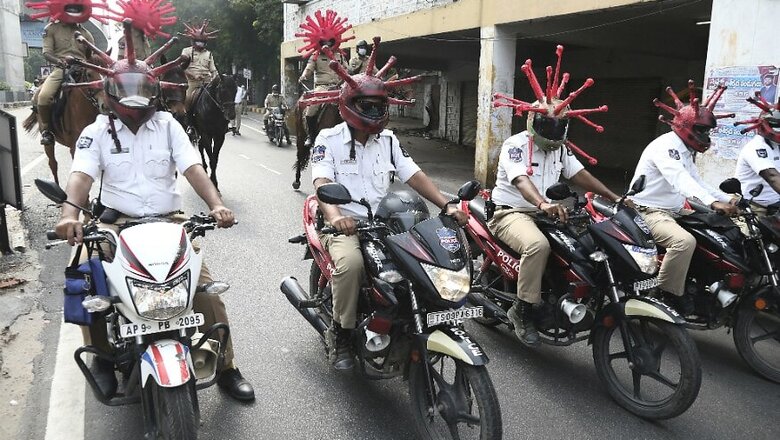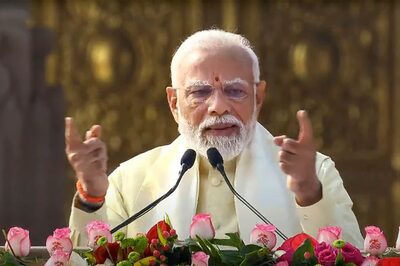
views
India has been under total lockdown since March 24, resulting in largescale socio-economic disruptions. While a lockdown is unavoidable as a temporary measure, we need to continuously assess it, given the massive social, economic and administrative costs it dovetails.
Firstly, the economy has more or less come to a standstill. Q2 output for 2020-21 will mostly contract and massive job cuts look certain. The impact will be felt over a long term because the economy will at best limp and crawl on a tortuous road to recovery.
Secondly, with large-scale disruption of healthcare facilities pertaining to non-Covid-19 illnesses, morbidity and mortality is likely have increased. Reports say tribal communities living in remote areas continue to suffer with snake bites, difficult deliveries etc., but are not being treated because there are no vehicles to transport them.
Patients in cities and towns undergoing treatment for tuberculosis are not being able to access treatment. A lot of private clinics across many parts of India are closed because their staff cannot commute to work in the lockdown.
Thirdly, the uncertainty and panic created with the lockdown has led to massive homeward movement of migrant workers. Supply chains for essential commodities are disrupted. Extremely limited state capacity is being diverted to deal with these situations instead of being allowed to focus single-mindedly on containing the outbreak.
As a result, the best minds in the administration (and there is an extremely limited supply here) are being used to fire-fight other issues, instead of thinking about how best to minimise Covid-19 damage. And despite these costs, it is not that the lockdown strategy is working perfectly. One sees crowds in shops, markets and bus-depos as people deal with the massive uncertainty. It is not possible to have a perfect lockdown over unspecified horizons in a country like India.
What is the logic behind having a lockdown? In the SIR (Susceptible-Infected -Recovered) model of epidemiology, if you do nothing when a new virus attacks, case load shoots upfront and then subsides as a society develops immunity. You can try and mitigate by enforcing social distancing, washing hands continuously, wearing masks, and minimising the case load to wait out the storm.
Lockdown, on the other hand, is an important component of the suppression strategy, which postpones maximum case-load till it is lifted. It’s a strategy to buy us time, enabling us to prepare our healthcare and other systems to meet the storm head on when the time comes. So, when we are ready, lockdown has to be eased.
It is essentially a strategy to actively engage with the disease, rather than a passive method of burying one’s head in the sand till the storm has passed. The first component of dealing with this is to be prepared for the worst. But to be prepared for the worst, we need to have an idea of how bad the situation can get. That needs the data.
We have some estimates from organisations like the Center for Disease, Dynamics and Policy. Their forecasts have been challenged, with some experts claiming them to be too gloomy. It is fine to disregard these if we have good reasons, but we need some estimates in order to be prepared.
We already have the data from Europe, US and China. This might not hold out exactly in India, but can be used as prior information to be matched with the emerging sampling data in India. Statisticians refer to this combination of prior information and sampling as the Bayesian method. This can be used to evolve dynamically changing estimates of how the situation is evolving. We have enough and more systemic capacity to do this. It is really paradoxical that we have made virtually no use of the country’s rich and vaunted statistical abilities.
Once we have a fair idea of how bad things can get, we need to quickly figure out the time needed to achieve the necessary preparedness. Once we have this in hand, we can add 10% more time as a precaution and declare well in advance the date on which we will possibly end the lockdown.
To be able to do this we need more data. This can happen only by intensifying random testing. We need to test randomly since 85 per cent of the affected individuals could stay asymptomatic, going by the data from China, European and other countries. Testing only those showing symptoms will be sampling selectively, rather than randomly, and will also exaggerate the predicted mortality rates, since the denominator will be smaller than what it should be.
Mortality is the number of deaths divided by total number infected, and not total deaths divided by those showing symptoms. Those showing symptoms will be a smaller set, and hence overestimate mortality, leading to unnecessary alarm.
Lack of data is like shooting in the dark. With such uncertainty, political leadership may become extremely risk averse, persisting with lockdown as a way of avoiding downside risks rather than as a strategy to deal with the epidemic. Currently, lack of random testing seems to have been motivated by the belief that community transmission has not taken place, and it is enough to simply trace those who have returned from abroad along with those who may have come in their contact. But random testing will at-least validate this untested and dangerous assumption, which will be a relief.
It is important to announce the date of lifting the lockdown well in advance and in a committed fashion. It should be repeatedly communicated to the nation by the highest political leadership of the country.
Once we have declared the date for lifting the lockout, apart from dealing with the fresh case load, we will have to take steps to re-boot the economy. Supply chains are likely to have been disrupted, and will take time to fully start up. Workers will need to return to cities, and will have no means of a living till the next pay check. Establishments will not be able to make payments for supplies, having had no revenue for some time. Those who depend on informal credit might find that their sources have dried out. Policies will have to be evolved to deal with this situation.
Thus, lifting the lockdown will require preparedness and coordination with several agencies and states. Out-of-the-box solutions will have to be thought out. All this will require time and state capacity to think through the situation. None of this is possible unless we know a plausible date for an end to the current lockdown.




















Comments
0 comment